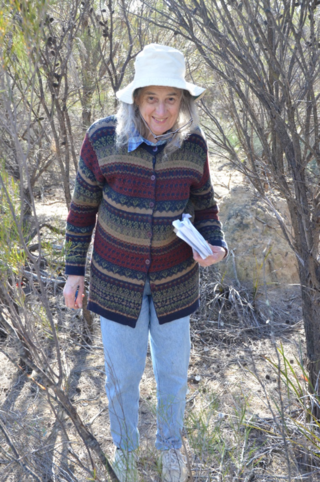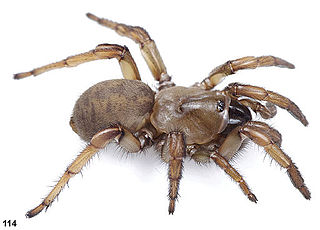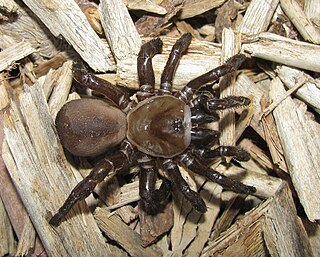
The Mygalomorphae, or mygalomorphs, are an infraorder of spiders, and comprise one of three major groups of living spiders with over 3000 species, found on all continents except Antarctica. Many members are known as trapdoor spiders due to their creation of trapdoors over their burrows. Other prominent groups include Australian funnel web spiders and tarantulas, with the latter accounting for around one third of all mygalomorphs.

Ctenizidae is a small family of mygalomorph spiders that construct burrows with a cork-like trapdoor made of soil, vegetation, and silk. They may be called trapdoor spiders, as are other, similar species, such as those of the families Liphistiidae, Barychelidae, and Cyrtaucheniidae, and some species in the Idiopidae and Nemesiidae. The name comes from the distinctive behavior of the spiders to construct trapdoors, and ambush prey from beneath them.

The family Cyrtaucheniidae, known as wafer-lid trapdoor spiders, are a widespread family of Mygalomorphae spiders.

Idiopidae, also known as armored trapdoor spiders, is a family of mygalomorph spiders first described by Eugène Simon in 1889. They have a large body similar to tarantulas.

Nemesiidae, also known as funnel-web trapdoor spiders, is a family of mygalomorph spiders first described by Eugène Simon in 1889, and raised to family status in 1985. Before becoming its own family, it was considered part of "Dipluridae".

Barychelidae, also known as brushed trapdoor spiders, is a spider family with about 300 species in 42 genera.

Antrodiaetidae, also known as folding trapdoor spiders or folding-door spiders, is a small spider family related to atypical tarantulas. They are found almost exclusively in the western and midwestern United States, from California to Washington and east to the Appalachian mountains. Exceptions include Antrodiaetus roretzi and Antrodiaetus yesoensis, which are endemic to Japan and are considered relict species. It is likely that two separate vicariance events led to the evolution of these two species.

Migidae, also known as tree trapdoor spiders, is a family of spiders with about 100 species in eleven genera. They are small to large spiders with little to no hair and build burrows with a trapdoor. Some species live in tree fern stems. They have a Gondwanan distribution, found almost exclusively on the Southern Hemisphere, occurring in South America, Africa, Madagascar, Australia, New Zealand and New Caledonia.

Ambush predators or sit-and-wait predators are carnivorous animals that capture or trap prey via stealth, luring or by strategies utilizing an element of surprise. Unlike pursuit predators, who chase to capture prey using sheer speed or endurance, ambush predators avoid fatigue by staying in concealment, waiting patiently for the prey to get near, before launching a sudden overwhelming attack that quickly incapacitates and captures the prey.

Cyclocosmia is a genus of mygalomorph trapdoor spiders in the family Halonoproctidae, first described by Anton Ausserer in 1871. Originally placed with the Ctenizidae, when the family split in 2018, this genus was placed with the Halonoproctidae as the type genus. The name is derived from the Greek "kyklos" (κυκλος), meaning "circle", and "kosmeo" (κοσμεω), meaning "to adorn".

Aptostichus bonoi, or Bono's Joshua Tree trapdoor spider, is a morphological species of Euctenizidae spiders, nocturnal arthropods who seize their prey after leaping out of their burrows and inject it with venom. The species was found in Joshua Tree National Park, California, and described by the Auburn University professor Jason Bond in 2012. Only seven species of Aptostichus were known prior to 2012, including the Angelina Jolie trapdoor spider.

The Euctenizidae are a family of mygalomorph spiders. They are now considered to be more closely related to Idiopidae.

Eucteniza is a genus of trapdoor spiders in the family Euctenizidae containing at least 14 species occurring in Mexico and the southern United States. Species are distinguished by a softened rear portion of the carapace, and males possess large spines on the first two pairs of walking legs that are used to hold females during mating. Like other trapdoor spiders they create burrows with a hinged lid, from which they await passing insects and other arthropods to prey upon. Many species are known from only one or two localities, or from only male specimens. More species are expected to be discovered. Eucteniza is closely related to spiders of the genera Entychides and Neoapachella.

Barbara Anne York Main was an Australian arachnologist and adjunct professor at the University of Western Australia. The author of four books and over 90 research papers, Main is recognised for her prolific work in establishing taxonomy for arachnids, personally describing 34 species and seven new genera. The BBC and ABC produced a film about her work, Lady of the Spiders, in 1981.

Aptostichus stanfordianus, the Stanford Hills trapdoor spider, is a species of wafer-lid trapdoor spider (Euctenizidae) endemic to California in the United States.

Gaius villosus is a species of spider in the family Idiopidae found in Western Australia in a variety of different habitats.

Halonoproctidae is a family of mygalomorph spiders, split off from the family Ctenizidae in 2018. Species in the family are widely distributed in North and Central America, Australasia, Asia, southern Europe and North Africa. One species is recorded from Venezuela in South America. They are relatively large, sombrely coloured spiders, that live in burrows with some kind of trapdoor.

Avicularioidea is a clade of mygalomorph spiders, one of the two main clades into which mygalomorphs are divided. It has been treated at the rank of superfamily.


















